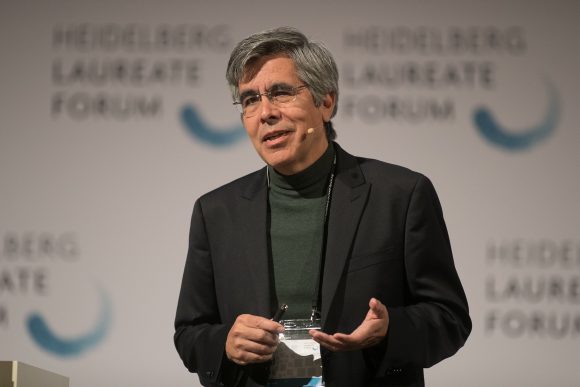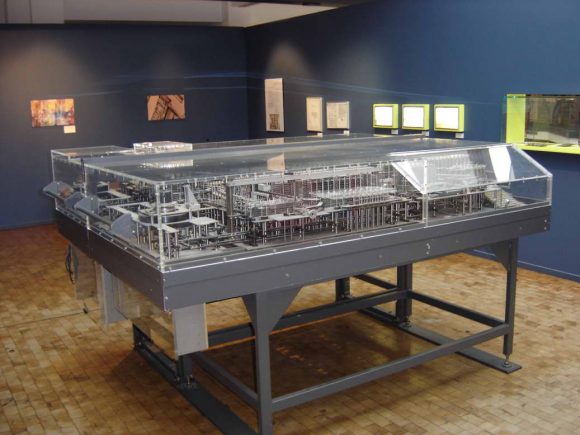aNewDomain — Most Americans acquainted with computer history credit one or all of three American-built systems as the world’s true first computers. Those are John Vincent Atanasoff and Clifford Berry’s ABC (1942), Aiken’s MARK I (1944) and J. Presper Eckert and John Mauchly’s ENIAC (1946).
— Most Americans acquainted with computer history credit one or all of three American-built systems as the world’s true first computers. Those are John Vincent Atanasoff and Clifford Berry’s ABC (1942), Aiken’s MARK I (1944) and J. Presper Eckert and John Mauchly’s ENIAC (1946).
But here in Heidelberg at the Heidelberg Laureate Forum (HLF 2016), AI professor and computing historian Raul Rojas made an excellent case for the pioneering role played by the binary computers of Konrad Zuse. In the question and answer session that followed his talk, Rojas politely stopped short of declaring Zuse the inventor of the first true computers. But I say Zuse deserves the credit.
Decide for yourself below, where I’ve compiled 10 facts worth noting about Konrad Zuse and the Z1, Z2, Z3 and Z4 computers he designed and built between 1935 and 1945. Below the fold, find links to go deeper on Konrad Zuse and the architecture and inner workings of his first computers.
Ed: Scroll below the fold to watch Rojas’ lecture in full.
- The ABC, MARK I and the ENIAC all arrived in the early to mid 1940s, years after Zuse completed his first fully binary computer, the Z1, in 1938.
- Unlike the American computers above, the Z1 was fully programmable, completely binary and supported floating point operations. American computers built around the same time weren’t binary. And floating point support didn’t emerge until the 1950s, as Rojas pointed out in his talk here.
- The Z1 also was the first computer to feature separate means of storage and control. The MARK, unlike the ENIAC and the ABC, was binary like the Z1. But it didn’t separate storage and control, which is of course how modern computers are designed. And it arrived later.
- By any definition, Zuse’s company, Zuse-Ingenieurbüro Hopferau, was most certainly the world’s first tech startup and first computer company. From the very start Zuse “wanted to commercialize his computer,” Rojas said, adding that “his company was specifically designed to build and sell computers.” It was even venture-capital backed. Zuse raised money through ETH Zürich and an IBM option on his patents. True to wha
 t would become Silicon Valley tech pioneer tradition, Zuse built that first computer in his parents’ Berlin living room — “because this was Berlin, after all, not Silicon Valley. So there was no garage,” Rojas said. Zuse’s overarching dream was to create a small computer for business and scientific use.
t would become Silicon Valley tech pioneer tradition, Zuse built that first computer in his parents’ Berlin living room — “because this was Berlin, after all, not Silicon Valley. So there was no garage,” Rojas said. Zuse’s overarching dream was to create a small computer for business and scientific use. - In 1936, Zuse applied for and received a patent application (#Z23139/GMD Nr. 005/021) for a programmable device, with data that can be permanently stored and always modified. In this, his patent suggests a von Neumann architecture, which didn’t reappear in any computer of any stripe until 1945. The Zuse patent appears to be the first computer system-related patent.
- To support his system, Zuse built the very first high-level programming language, which he called Plankalkul. (Programs, in Zuze’s terminology were called “plans.”) The language, which contains several of the typical characteristics of today’s programming languages, was years ahead of its time, too. FORTRAN didn’t arrive until nearly a decade later.
- Zuse used Plankalkul to design the world’s first chess program. Another world first in an early career chock full of them.
- Zuse’s Z3 (1941) was by any definition also the world’s first fully functional programmable computer. That is an important distinction, one that pretty much sews up the argument for me.
- You can find detailed description of how Zuse’s architecture — including its logic gates and relays — worked. Find that here. Unfortunately, Zuse didn’t document his work as he progressed from design to construction on each iteration. “He really was the first computer
 scientist because he never documented anything,” Rojas joked. However, because the Z1 was destroyed in Allied bombardments during World War II, Zuse set out to reconstruct it from memory in the 1980s. One of his drawings is at right. A model of the Z1 under glass, as shown in a museum exhibition, is at left. Find all the drawings here.
scientist because he never documented anything,” Rojas joked. However, because the Z1 was destroyed in Allied bombardments during World War II, Zuse set out to reconstruct it from memory in the 1980s. One of his drawings is at right. A model of the Z1 under glass, as shown in a museum exhibition, is at left. Find all the drawings here. - Even Zuse’s last computer, the Z4, which was initially funded by Nazi Germany’s Aerodynamic Research Institute, beat revolutionary computers like the Univac (1950) to the punch. It arrived a year earlier — in 1949.
Head here to check out an amazing 360 degree panorama of the Z1, as reconstructed. There’s also an impressive 3D simulation of his adder here. In addition, I’ve embedded Rojas’ academic paper on Zuse, published in the IEEE Annals of the History of Computing in 1997, below the fold.
Here is the full video of Rojas’ lecture on Zuse:
On Konrad Zuse Z1 and Z3 by Raul Rojas uploaded by Gina Smith on Scribd
From top: Photo of Prof. Raul Rojas delivering his Konrad Zuse talk: Heidelberg Laureate Forum Foundation / Kreutzer, All Rights Reserved. Image of the Z1: by ComputerGeek, CC BY-SA 3.0, All Rights Reserved; image of Konrad Zuse drawing and cover image of the Z1 computer up close: Zuse.Z1.Zib.de, All Rights Reserved.













